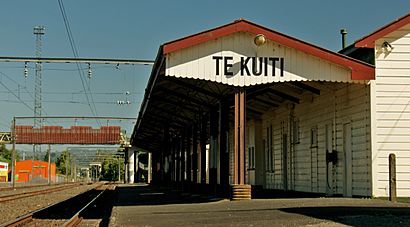Te Kuiti railway station facts for kids
Quick facts for kids
Te Kuiti railway station
|
|
|---|---|

Te Kuiti Rail Station
|
|
| Location | New Zealand |
| Coordinates | 38°20′09″S 175°09′58″E / 38.335732°S 175.166187°E |
| Elevation | 54 m (177 ft) |
| Line(s) | North Island Main Trunk |
| Distance | Wellington 475.66 km (295.56 mi) |
| History | |
| Opened | 2 September 1887 goods 2 December 1887 passenger |
| Closed | 24 June 2012 except for groups of 10+ |
| Rebuilt | 1908, moved 1911, extended 1929, 1951 and 1957 |
| Electrified | June 1988 |
| Designated: | 5 September 1985 |
| Reference #: | 4450 |
The Te Kuiti railway station is an important stop on the North Island Main Trunk railway line in New Zealand. It played a big role in the growth of the town of Te Kuiti.
The first express trains from Auckland to Wellington started running on 14 February 1909. These trains took about 19 hours and 13 minutes and always stopped at Te Kuiti. Over the years, many famous trains have stopped here. These include The Overlander, Blue Streak, Scenic Daylight, Daylight Limited, Northerner, and Night Limited. Since 2012, trains only stop at Te Kuiti for special trips or for groups of 10 or more people who have booked tickets on the Northern Explorer.
Goods trains first started using the station in October 1887. They ran on Mondays and Fridays. The station building and engine shed were still being built at that time. Passenger services were added on 2 December 1887, also on Mondays and Fridays.
Te Kuiti Station: A Special Building
Since 1985, the Te Kuiti railway station has been listed as a NZHPT Category II building. This means it's a special historical place that needs to be protected. The Rail Heritage Trust says it's the best example of a "standard class B station" left in New Zealand.
The station was built in 1908. It was designed by George Troup, who was the main architect for railways at the time. He is also famous for designing the beautiful Dunedin railway station. The original Te Kuiti station was moved to another town called Ongarue.
In 1911, the station was moved again. It went from the west side of the tracks to the east side, which is closer to the town. A covered porch, called a verandah, was also added. The building is made of weatherboard, which is a type of wooden siding, and has a corrugated-iron roof. It has a pointed roof shape, called a gable, at both ends.
When it was first built, the station was about 30 meters (103 feet) long. It was made even longer in 1929, 1951, and 1957. You can see these changes because some windows are double-hung (they slide up and down) and others are casement windows (they open outwards like a door). In 2014, a "Revitalisation Project" began to make the station even better. The plan is to use it for art and craft groups, an education center, youth projects, history displays, and a meeting room.
Images for kids



